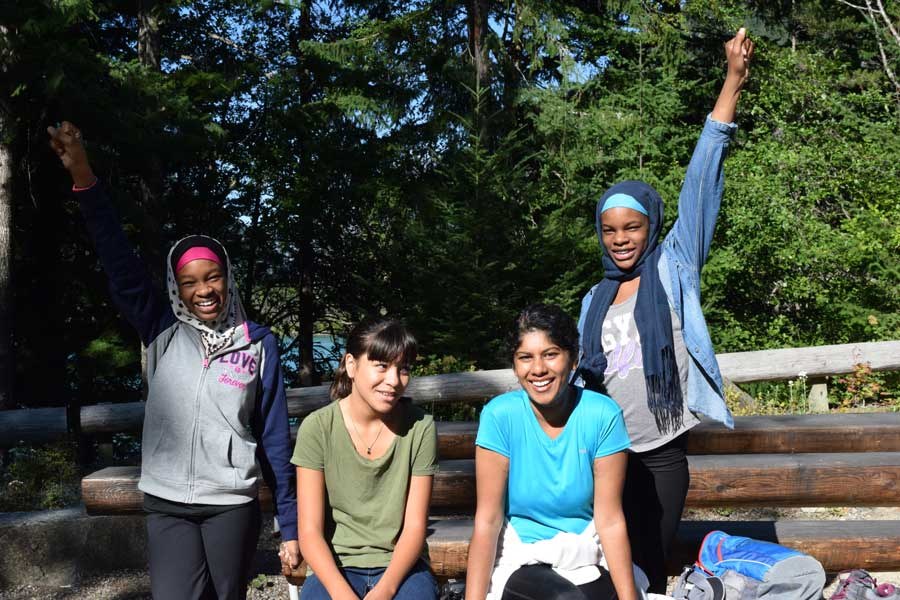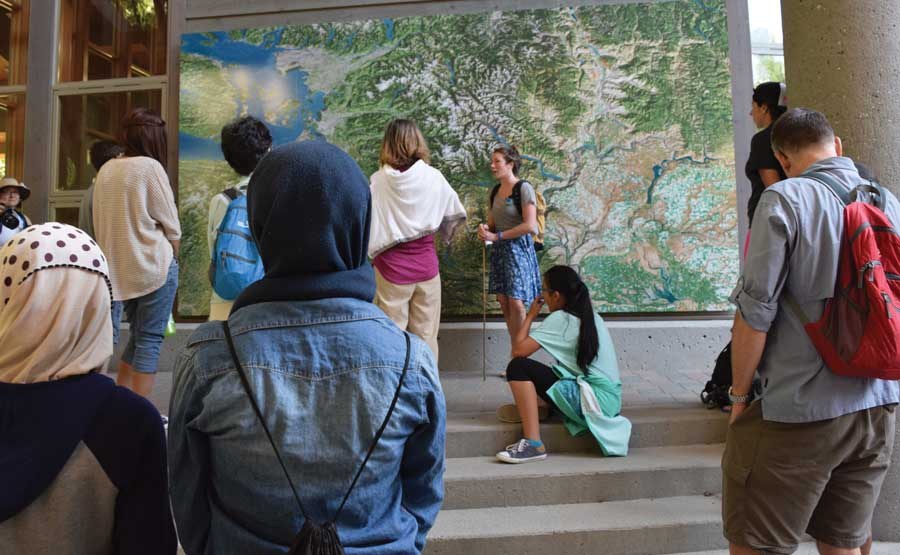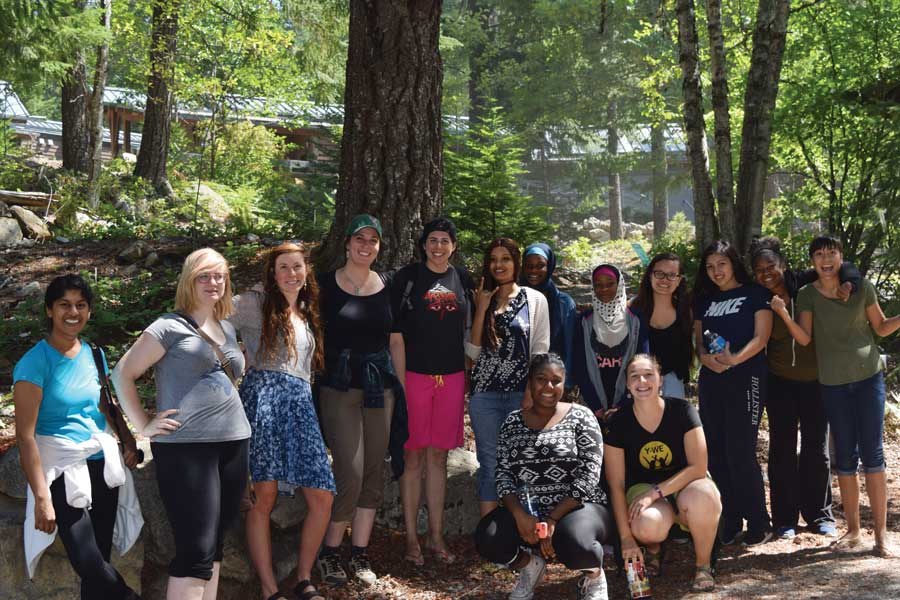
It was around 9pm on a Wednesday night, June 8, when I received word that The Mountaineers was a recipient of an Explore Fund grant from The North Face. This grant provides us the financial support to take Mountain Workshop youth to North Cascades National Park as part of their 2016/2017 program. This grant was one of the first grants I applied for since joining The Mountaineers staff earlier in the year, making the win all the more special.
During the grant writing process, I learned the ins-and-outs of our Mountain Workshops youth program, including that this program is our largest youth program and was designed specifically to serve underserved and minority youth. The findings from The Nature Conservancy’s 2011 study, “Connecting America’s Youth to Nature” had been well-documented in previous grant applications. Eighty percent said it was uncomfortable to be outdoors due to things like bugs and heat, 62 percent said they didn’t have transportation to natural areas, and 61 percent said there weren’t natural areas near their homes. For our application to the Explore Fund, I wanted to dig a little deeper into research specific to minority and underserved youth to shape our story.
Environmental-Based Education and EIC Models
In 1995, as the achievement gap became more prominent, it became clear that little research existed to measure the effect that environmental education had on a student’s success. This resulted in sixteen State Departments of Education and the Pew Charitable Trust uniting to form the State Education Environmental Roundtable (SEER) to promote Environment-Based Education (EBE). EBE is the framework SEER developed to “focus on standards-based educational results by using the environment and related issues as a context for instruction.”
EBE’s three major goals (www.seer.org):
- Help students achieve success with academic content standards
- Develop a student’s understanding of interactions between natural and human social systems
- Prepare students to be active members of a civil society with the skills they need to identify and resolve environmental issues.
In 1998, SEER published ‘Closing the Achievement Gap: Using the Environment as an Integrating Context (EIC) for Learning’ and now focuses its efforts on working with schools to implement the EIC model. The EIC model “uses a school’s surroundings and community as a framework within which students can construct their own learning, guided by teachers and administrators using proven educational practices.”
Since implementing the EIC model, SEER has found that overall:
- Students show an increase in knowledge and understanding of science concepts
- Demonstrate a better ability to apply science to real-world situations
- Show a greater enthusiasm and interest in learning science
Additional studies focused specifically on Black and Hispanic youth and found that those who participated in EIC performed better on standardized tests, were more engaged in school, had stronger critical thinking skills, increased volunteer participation, and an increase in achievement motivation.
When I shared this research with our Education Director, Becca Polglase, she exclaimed, “this is Mountain Workshops!” While difficult to specifically measure our Mountain Workshops program, this research shows that this program is structured to transform the lives of underserved and minority youth.

My Experience with Y-WE
Over the summer, I had the opportunity to serve as a mentor on one of the trips to North Cascades Institute (NCI) with youth from Young Women Empowered (Y-WE), one of our newest Mountain Workshops partners and the group we are using to pilot taking youth to national parks. Y-WE provides mentorship and empowerment programs for teen women in the greater Seattle area. Over 70% of the youth are immigrants to the United States and 80% of the youth and 50% of the adults are women of color.
“I wanted to let you all know that I’ve already confirmed there are no Poke Stops at NCI,” I said while nine youth unloaded their bags from vehicles in the parking lot at NCI.
“Huh?” one of them said while others looked at me with curious eyes. It was clear then that none of them were into Pokemon Go. I realized then, the weekend was going to be a success. (Side note: the prior weekend I had been at a Seattle park with my family and a majority of people in the park had their eyes glued to their cell phone in search of digital creatures.)
After helping to assist youth to their rooms, I connected with Margaux Gottlieb, our youth program coordinator, and my staff support for the weekend, and Anna McCraken, Y-WE’s Nature Connections Program Coordinator. We discussed the weekend agenda loosely, which included a meet-and-greet with all youth, staff, and volunteers, trust building exercises, and an agenda of outdoor activities — including a hike up to Diablo Lake Overlook. NCI staff also gave a presentation of the effects of natural fires and glacial ice. I spent a majority of my weekend with Y-WE youth observing the program, getting to know the young women and helping Margaux and Anna when needed. My participation in the trip was to observe this pilot program and report back to The North Face about youth engagement.
On the second day, I was given the role of leading the fast group up to the Diablo Lake Lookout. I, along with two Y-WE youth volunteers and four youth, set out together.
“Have we walked a mile yet?” one asked, while we made our way up the trail. I checked my watch — we had barely walked ten minutes, it was impossible to have walked a mile.
“No, not yet. We’re close though,” I said.
A few minutes later, “We must have walked over a mile by now. I’m sweaty and there are all these bugs,” the same youth said again, “Let’s take a break for some water.” One of the Y-WE youth volunteers, who knows how to encourage these youth, began the “you can do this!” speech.
I chimed in with, “For me, the best thing to do when hiking is not to worry about how far you get but rather how long you’ve hiked. Let’s try hiking for 45 minutes and not worry about how far we get.” After minimal resistance, the youth agreed we could hike for 45 minutes and not stop. We were back on track to get to Diablo Lake Lookout.
While walking, I thought about the research I had read about why urban youth don’t get outside; bugs, not having proper clothing, not having access to natural areas to experience the outdoors in. I was humbled. I take my ability to get outside for granted. I have a car, proper gear, clothing and an interest in the outdoors because it has been such an inspiring and grounding part of my life. Being outdoors and being active makes me happy, keeps me calm when I’m stressed and allows me to feel good about my overall health. But my experience with the Y-WE youth showed me that there are many who don’t have access to these areas. And when you’re living in Seattle and can see Mount Rainier, the Olympics, and the Cascades from your home or school, if you don’t have the opportunity to visit these places, they become a backdrop rather than a destination to explore.
We didn’t make it to the Diablo Lake Lookout but we did make it up about halfway to another lookout. “We made it to a lookout!,” I exclaimed. “Isn’t it awesome?!” We all stopped to take in the view.
“Can we keep going?” one youth asked, while others resisted the idea. One of the Y-WE volunteers stepped in, “If we all don’t want to continue going, we have to turn back.” We decided to head back down. But before we left, I was able to snap a picture of the group and asked if we could sit in silence for three minutes to listen to the sounds of nature. We did.

Inspiring Finishes
On our way back down, we ran into Margaux and Anna who were leading the second group. Cheers and high-fives were shared. I heard one of the youth in my group say to the other, “you should keep going, the view is awesome.” A smile crept across my face. Although we didn’t make it all the way to Diablo Lookout as I had hoped, I was still thrilled. This hike wasn’t about how far we could get but rather the experience that could be shared.
After the hike, we all planned to meet on the beach to celebrate our hike that day. While we were sitting on the sand, one of the youth jumped up, “Ew, a bug!” she screamed.
“Calm down, it’s okay. It’s just an ant. That ant is probably meandering around with no interest in running into you. It’s probably looking up at you like, ‘Oh my gosh, what’s that?!!!!’. You’re like a million times bigger than that ant, remember that.” Another youth who had overheard the exchange turned back toward me and said, “you’re very motivating!” I smiled back as my heart filled with joy from a successful trip with Y-WE to the North Cascades Institute.
While in the short term, these youth may feel like this was just a trip to the outdoors, in the years to come, they’ll reflect back at this time and be inspired to hit the trails again. Parents and guardians of these youth also notice the impact the weekend had on the girls. One guardian wrote to Y-WE; “The first thing I noticed about our granddaughter when she returned from Y-WE was how relaxed she looked; confident and happy. A 4-mile round trip hike was easily managed, she reported, and the food was great! She had not stayed overnight with anyone outside the family for at least two years, and we’re glad this went so well.”
Through our work at The Mountaineers, I hope this type of outreach can be continued into the future. These are the youth who will be the future leaders of our country, and hopefully also strong stewards of our environment.
 Leone Kraus
Leone Kraus